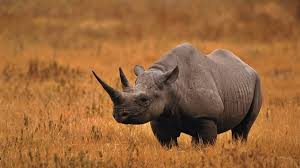Context:
Innovative Strategy by South African Scientists to combat Rhino Poaching.
Key Highlights
- South African scientists have developed an innovative strategy, known as the Rhisotope project, to tackle rhino poaching.
- By injecting radioactive material into live rhino horns, the project aims to achieve two primary objectives:
- Enhancing detectability at border checkpoints and
- Rendering the horns unsuitable for human consumption, thereby dissuading poachers.
- Scientific Implementation: The project involves inserting two small radioactive chips into the horns of 20 rhinos.
These chips emit low-dose radiation, carefully designed to be detectable by radiation sensors at international borders while posing no harm to the rhinos or the surrounding environment. - Impact on Rhino Conservation Efforts: South Africa harbors the largest population of rhinos globally, housing approximately 80% of white rhinos and 33% of black rhinos, according to the International Rhino Foundation.
With poaching posing a significant threat to these populations, innovative solutions like the Rhisotope project are crucial for their protection. - Optimism and Final Phases of the Project: Optimism about the project’s efficacy in combating poaching, noting the failures of previous methods like dehorning and poisoning.
The project, culminating after three years of development, has entered its final phase with the successful insertion of radioisotopes into rhino horns.

IUCN Red list
- The IUCN Red List, compiled by the International Union for Conservation of Nature, is a global report card tracking the conservation status of species, indicating how close they are to extinction.
Current Status of Rhinoceros:
- There are five remaining rhino species in the world, classified into two groups based on continent of origin.
African Rhinos
- Black Rhinoceros: Smaller of the two African species.
- Critically Endangered (IUCN Red List) due to poaching for their horns.
- Listed in CITES Appendix I
- White Rhinoceros: Largest land mammal in Africa after the elephant.
- Near Threatened
Asian Rhinos
- Greater One-Horned Rhinoceros
- Also called Indian Rhinoceros.
- Found in the Indian subcontinent and IUCN red-listed as Vulnerable.
Javan Rhinoceros
- Critically endangered rhino species.
- Found in Indonesia.
- Has a single horn.
Sumatran Rhinoceros
- Smallest rhino species.
- Found in Sumatra and Borneo.
- Critically Endangered.
- Has two horns.
- Western Black Rhinoceros was declared extinct in 2013 due to heavy poaching for their horns.
- Only two Northern White Rhinos remain, both females kept under close watch in Kenya. This subspecies is functionally extinct in the wild.

